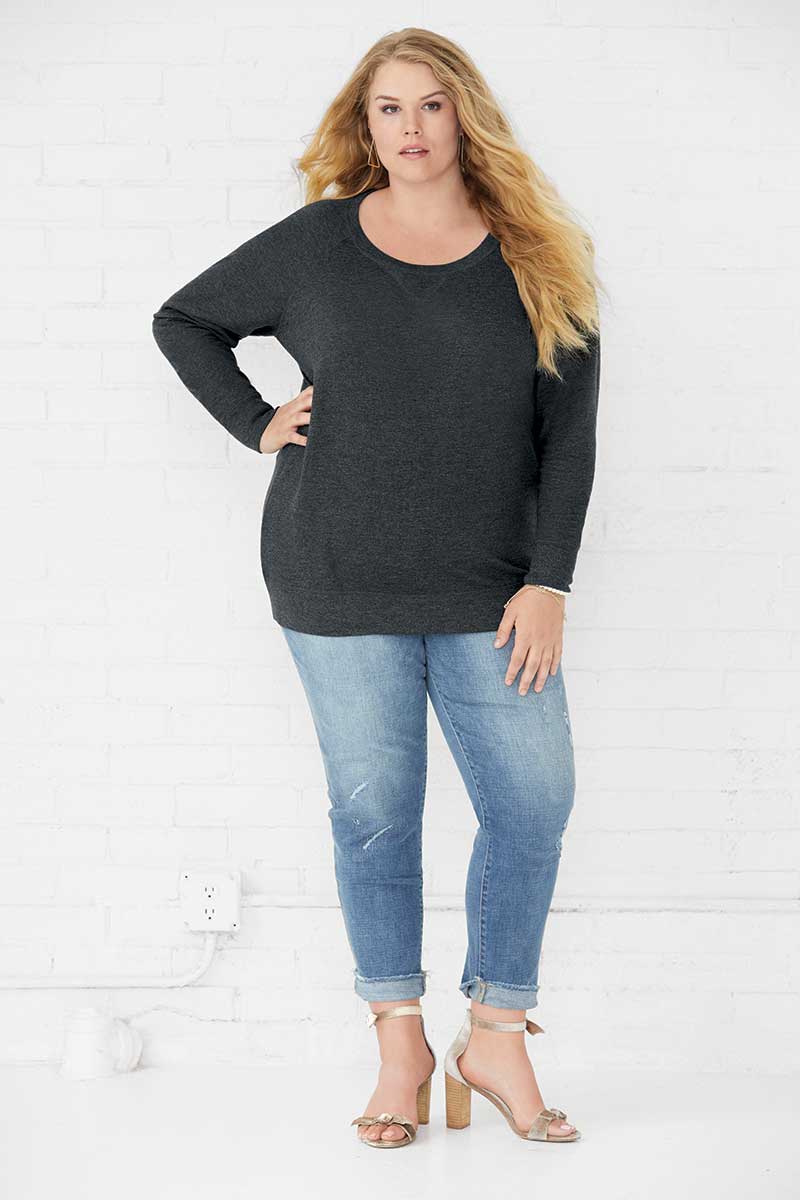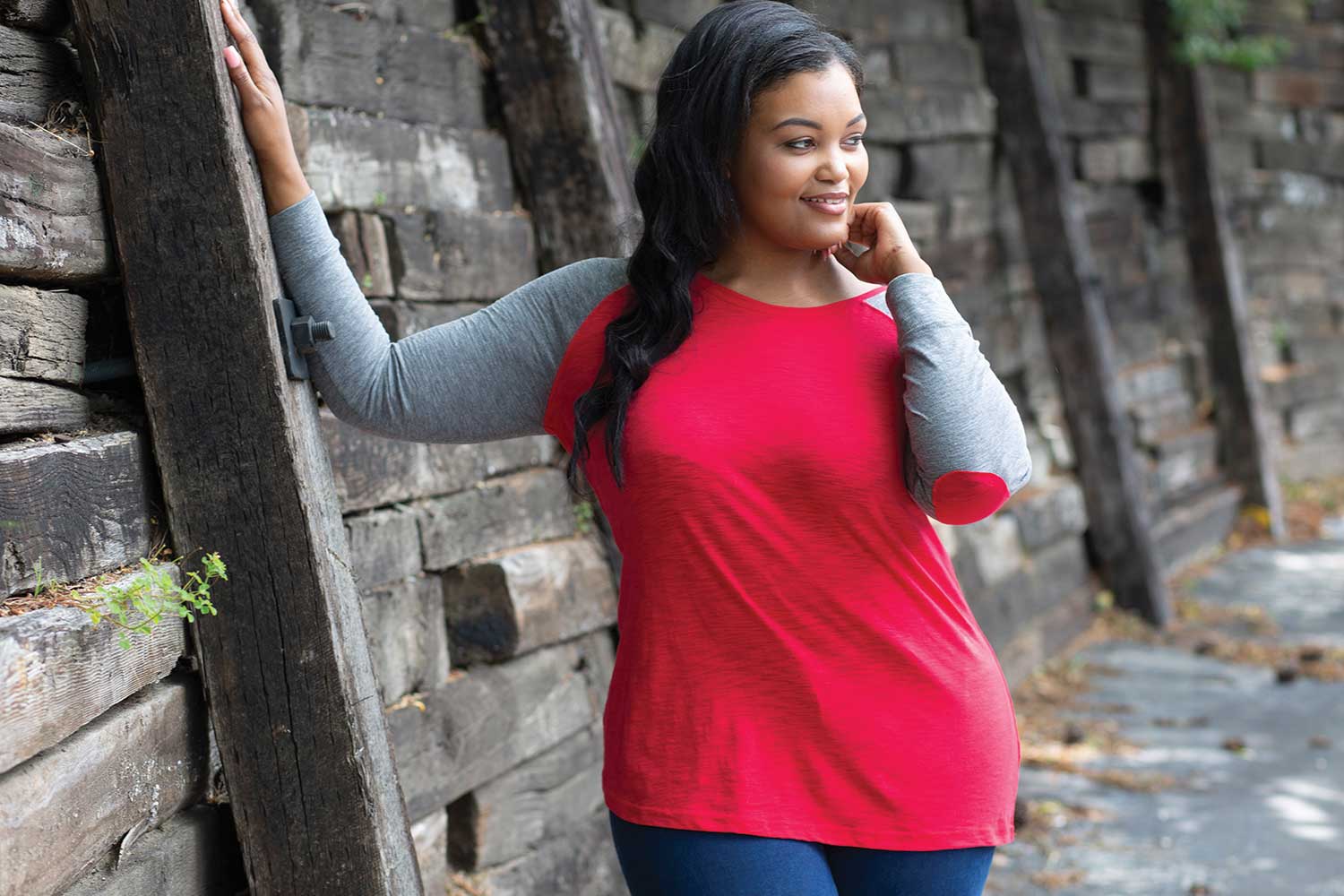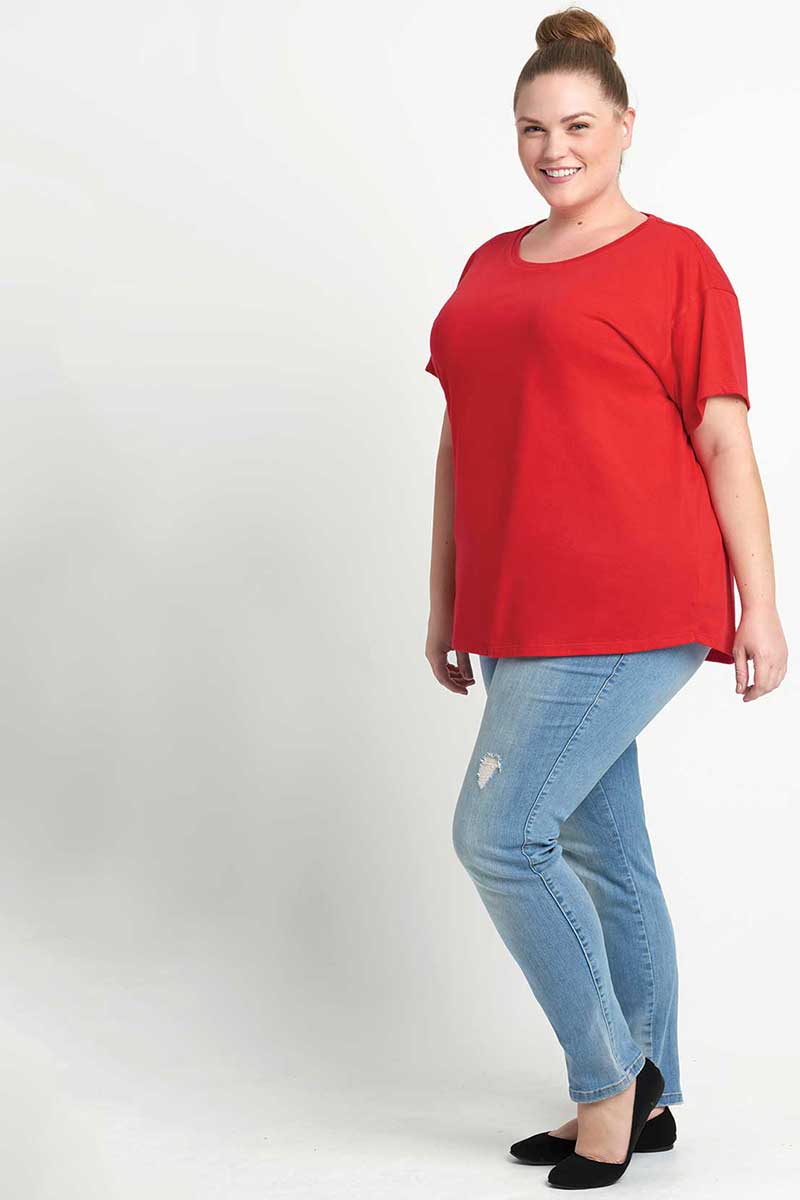For a logoed wearable to really represent a brand well, it needs to make the wearer feel good about him or herself. Apparel suppliers have done a better job of that over the decades by inching closer to a retail-like look and feel. But no amount of soft fabric and high-end performance properties will matter if one major detail is ignored. “Design is certainly important. However, ensuring quality fit at all sizes is an essential factor in consumer satisfaction,” says Christina Onusko, director of block and grading services at Alvanon, which advises leading apparel brands on fit and sizing.
The key word – the area where the fashion industry has historically fallen short – is all. Retailers can theoretically pick and choose their target customer to sell to. Apparel decorators and distributors, on the other hand, only succeed when they capably outfit every member of a team or group – including the people whose body types aren’t what society deems “normal.”
Because what is normal? Is it the approximately 68% of American women who wear a size 14 or above? The nearly 73% of American men who are overweight (along with 63% of women)? The U.S. Centers for Disease Control and Prevention found that since 1999-2000, men on average have gained more than 8 pounds and women about 7 pounds. According to U.S. News & World Report, “the increases in average weight, waist circumference and BMI were wide-ranging, affecting men and women, every age group and multiple racial or ethnic groups, researchers say.” The standard body type in America is rapidly changing and literally growing.
 Industry suppliers are creating fashion lines specifically for plus-size wearers. One example is the slouchy French terry pullover (3862), part of eight items in the Curvy line from LAT Apparel (asi/65948).
Industry suppliers are creating fashion lines specifically for plus-size wearers. One example is the slouchy French terry pullover (3862), part of eight items in the Curvy line from LAT Apparel (asi/65948).Pundits can debate whether this signals a health crisis in this country or if society continues to promote unrealistic beauty standards. The fact remains that both suppliers and distributors must be cognizant of providing garments to people of all sizes and body types. Not only is it a necessity, it’s a sales opportunity too; consider that retail plus-size apparel sales are slated to grow at 6% annually – more than double the overall apparel industry revenue. Industry supplier LAT Apparel (asi/65948) reports that sales in sizes 2XL and 3XL have grown 40% in the last two years, and that requests for 4XL, 5XL and 6XL have shot up too. And as Onusko points out, more than 80% of consumers say they will return to a brand specifically for the way it fits. Satisfied customers, at all sizes, who feel good in the clothes they purchase will make a company profitable.
Top suppliers say that even though the branded apparel industry lags behind retail in catering to this group, they’ve made important strides in increasing their range of available sizes and expanding their collections to offer far more choice to plus size and big and tall wearers. Distributors and decorators need to exercise due diligence by identifying the right suppliers and items, then guiding buyers to the garments that give everyone the fit they deserve. If it’s done successfully, everyone will be satisfied, and no one has to be excluded.
Suppliers Answer the Call
During her time as CEO of LAT Apparel, Gina Whisnant says it was her pregnancy that led the company to recognize the need for plus-size clothing. Size large men’s T-shirts were simply not a flattering answer. Out of her experience, the Curvy line was designed, which quickly caught on for the supplier. Now, Whisnant caters to a niche market, designing tees for drag racing fans through her company Psycho Speed Inc./PiranaZ Racing. She’s found that the majority of customers need larger sizing. “Eighty percent of our customers are plus-size women,” she says. “It’s so hard to find stylish, cute plus-style tops. I found a style at one supplier that we loved. We would sell out every weekend, but unfortunately the style was discontinued.”
Whisnant’s lament is a common one in the industry: the struggle to find garments sized and fitted for larger body types, and the lack of consistency in stock for those garments that do fit this audience.
“Curvy women want fashion and trend, just like any other person. They don’t want to be limited to the basics.”Kristin Slinn, Boxercraft
Some suppliers have heard those complaints and tried to address that demand. LAT Apparel offers eight different tops in its Curvy line – standard crewneck and V-neck tees, yes, but also baseball and football tees as well as a slouchy French terry long-sleeve pullover. “There has been a substantial ‘body positive’ movement across retail and media. Women are embracing their shape rather than trying to hide it,” says Jen Oleksik, design and merchandise manager at LAT Apparel. “In the past, decorators and customers of wholesale product typically felt that men’s T-shirts in a 2X or 3X were a suitable option. The reality is that men and women’s bodies, no matter the size, are built differently.”
The apparel industry historically has tried to pigeonhole plus-size women into more conservative clothing while making sacrifices on quality and selection. “Curvy women want fashion and trend, just like any other person,” says Kristin Slinn, director of merchandising at Boxercraft (asi/41325). “They don’t want to be limited to the basics.” The supplier’s selection of nine plus-size tops demonstrates that ethos, featuring cold-shoulder silhouettes, a patch elbow tee and a flannel button-down shirt available in eight different colors. “Body sizes are no longer limited by old thoughts that only certain body types can wear certain styles,” adds Slinn. “It’s my job as a designer to tailor the trends and cuts to work for any woman who wants to rock the latest trends and styles.”
Suppliers are attacking the problem in a number of ways. Many have expanded the range of sizes in their standard items, while others are developing garments that work across a range of body types. Next Level Apparel (asi/73867) has traditionally specialized in juniors-fit shirts for women, but has debuted garments like the dolman, relaxed V-neck and Ideal Flow tee that will appeal to women of all body types. “Is the garment a flattering fit for the shape of a plus-sized person?” asks Amanda Mitzman, marketing director for Next Level Apparel. “Many women who wear plus size dislike wearing a men’s shirt because of the length. They don’t want to wear a dress if they’re expecting to wear a T-shirt.”
 This preppy patch sleeve tee (PT66) is part of a collection of 10 plus-size tops from Boxercraft (asi/41325).
This preppy patch sleeve tee (PT66) is part of a collection of 10 plus-size tops from Boxercraft (asi/41325).Companies like LAT and Boxercraft have taken the extra steps of designing lines exclusively for plus-size women. It’s far different than offering a size 2XL shirt, says Slinn, which is just a standard garment that’s been sized up. “A plus-size grade allows for the actual changes in the shape of a womanly figure and for longer lengths, shaped necklines, tailored sleeves and armholes, as well as an A-line silhouette,” Slinn notes. “The style is truly made to fit and compliment a plus-size woman’s body.”
The discussion of body size typically tends to focus on women over men for good reason – their fit requirements are noticeably more complex. According to Alvanon, men’s shape is determined by a simple question: are they bigger on the top or bottom? Because that shape doesn’t change significantly with age, the only thing that adjusts is the men’s size. Plus, men’s apparel tends to be more standard and unisex in styling, narrowing the possible variations.
Still, larger men have sizing needs that aren’t always being met. “There’s always been a need for the big/tall market and many of our men’s styles go into extended sizes – 3X, 4X and in some cases up to 6X,” says Oleksik. She adds that LAT’s men’s styles are “a true men’s fit. It isn’t a slim cut or geared toward the young man.” Variations in height and weight account for the differences in offering specific lines of big, tall or big and tall garments.
All Shapes and Sizes
Alvanon is a global innovations company helping apparel brands improve how their clothes fit. Through its use of data, the company has mapped the body shape breakdown for American women ages 35-55, defined by their low hip to waist differential.
Body Type of American Women Ages 35-55
Percent of American Female Population
Successful Selling
Jamie Stone, president of Gifts by Design (asi/205947) in Seattle, WA, produces a lot of apparel for corporate events, which men and women of all sizes attend. “We’re sensitive to the idea that providing a different item for the big and tall participants sets them apart from the rest and calls them out in a way that nobody wants to be,” she says. “So we go out of our way to suggest options that have sizes to fit everyone. We look for lines that offer S-4XL or 5XL for men and XS-4XL for women, and sometimes larger sizes when requested by our clients.”
“Design is certainly important. However, ensuring quality fit at all sizes is an essential factor in consumer satisfaction.”Christina Onusko, Alvanon
That’s not an easy task, but Stone has a list of go-to suppliers she relies on and finds that others are increasingly expanding their size grids. “We’re seeing more and more suppliers getting on board with this,” she says. She namechecks a few large suppliers: SanMar (which offers most of their products up to 4XL), Cutter & Buck (women’s styles up to 3XL and men’s styles up to 5XL) and alphabroder (which carries over 80 items that scale up to 6XL).
Ashley Moss, a marketing specialist based in Rocky Mount, NC, with Top 40 distributor Geiger (asi/202900), would love nothing more than size consistency across suppliers. Since she understands that’s unlikely to occur, her advice is preparation. When it comes to outfitting large groups, Moss does advance homework. For instance, she’s currently working with a committee made up of members from 30 companies for a big conference later this year. “I go to one of their first meetings and bring a rolling duffle bag with all kinds of samples,” she says. As the committee looks at the various garments, Moss probes about colors and preferred styles. “The inevitable question I ask them is, ‘How large do you need me to be able to go up to this year?’” she says. “There’s one team in particular that always needs to go up to a 6X, so I’ll put half of what I brought back in my bag because it’s not available in that size. It’s a process of elimination.”
Of course, Moss does her best to head off frustration prior to her meetings by using her own go-to list of suppliers, such as Trimark (which offers men’s styles up to 5XL and women’s up to 3XL), Vantage Apparel (which has a Big & Tall collection) and alphabroder. She’ll make a list of which styles go up to the larger sizes, but even then that doesn’t always work. “Just this last time I had someone pick a color in a style that did go up to 6XL, but my email very clearly said which two colors that go up to 6X and they didn’t choose that color,” she says. “Unfortunately, I had to go back and say I can’t do that color all the way up to a 6X.”
 Many leading suppliers are offering expanded sizing and fashion cuts that fit a range of body types, such as the Ideal Flow tee (1530) from Next Level Apparel (asi/73867).
Many leading suppliers are offering expanded sizing and fashion cuts that fit a range of body types, such as the Ideal Flow tee (1530) from Next Level Apparel (asi/73867).Gifts by Design strives to present a client’s brand in a favorable light, and that’s not possible if certain wearers are unsatisfied or don’t look as good as the rest of the group. “The most important thing,” says Stone, “is to make sure everybody gets the same thing so larger individuals are not singled out by wearing a different item.”
Simply ignoring the size needs of end-users is a recipe for disappointment. “I think it comes down to us as distributors knowing our products before we show a customer,” Moss says. “It’s important to ask those questions on the front end so we don’t go in and offer a shirt and then have to tell them, ‘Oh I’m sorry, you can’t have that.’ ”
That’s why catering to the growing plus size and big and tall markets needs to be a combined effort between suppliers and distributors. Says Boxercraft’s Slinn: “We have to work to educate the need, and how to best sell plus-size product. … Buyers are hesitant to chart into new territories, but the facts and data are out there. Retail is paving the way and proving there’s a market for plus size. The promotional apparel market needs to educate how to market and bring in new and trendy products to appeal to their consumers.”